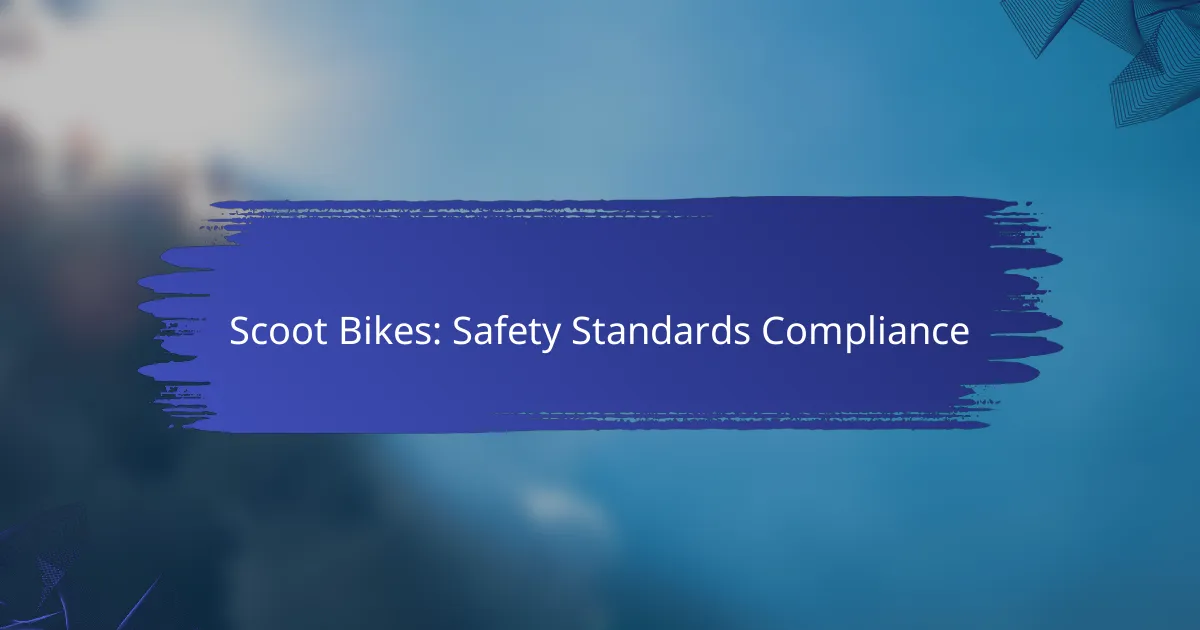Scoot Bikes offer a fun and convenient way to navigate urban environments, but they come with inherent risks. Common accidents include collisions with vehicles, falls due to uneven surfaces, and incidents related to weather or mechanical failures. By understanding these risks and adopting safe riding practices, such as wearing protective gear and staying vigilant, riders can significantly reduce the likelihood of accidents and enhance their overall safety.

What are common accidents involving Scoot Bikes?
Common accidents involving Scoot Bikes include collisions with vehicles, falls due to uneven surfaces, accidents caused by weather conditions, mechanical failures, and incidents involving inexperienced riders. Understanding these risks can help in taking preventive measures to ensure safety while riding.
Collisions with vehicles
Collisions with vehicles are one of the most serious risks for Scoot Bike riders. These accidents often occur at intersections or when riders attempt to merge into traffic without proper signaling. Riders should always be vigilant, use hand signals, and adhere to traffic rules to minimize the risk of such collisions.
To enhance safety, consider wearing bright clothing and using lights or reflectors, especially during low visibility conditions. Awareness of surrounding vehicles and maintaining a safe distance from them can significantly reduce the likelihood of an accident.
Falls due to uneven surfaces
Falls caused by uneven surfaces are common, particularly in urban areas with poorly maintained roads or sidewalks. Potholes, cracks, and debris can lead to loss of balance and subsequent falls. Riders should always scan the path ahead for potential hazards and adjust their speed accordingly.
Using Scoot Bikes on designated paths or smoother surfaces can help mitigate this risk. Regularly inspecting the riding area for obstacles before starting a ride is also advisable.
Accidents caused by weather conditions
Weather conditions can significantly impact riding safety. Rain, snow, or ice can make surfaces slippery, increasing the risk of falls. Riders should avoid riding in adverse weather conditions whenever possible and be cautious if they must ride in such situations.
When riding in wet conditions, reducing speed and increasing stopping distance is crucial. Wearing appropriate gear, such as waterproof clothing and shoes with good grip, can also enhance safety during inclement weather.
Mechanical failures
Mechanical failures can lead to accidents if a Scoot Bike is not properly maintained. Issues such as brake failure, tire punctures, or battery malfunctions can compromise safety. Regular maintenance checks are essential to ensure that all components are functioning correctly.
Riders should familiarize themselves with basic maintenance tasks, such as checking tire pressure and brake responsiveness. Keeping a checklist for routine inspections can help prevent mechanical issues while riding.
Inexperienced riders
Inexperienced riders are more prone to accidents due to a lack of familiarity with handling Scoot Bikes. They may struggle with balance, speed control, and navigating traffic. It is crucial for new riders to practice in safe environments before venturing into busier areas.
Joining a local riding group or taking a safety course can provide valuable skills and knowledge. Additionally, using Scoot Bikes in less crowded areas until gaining confidence can help reduce the risk of accidents.

How can riders prevent accidents on Scoot Bikes?
Riders can prevent accidents on Scoot Bikes by adopting safe practices, wearing protective gear, and staying vigilant. Implementing these strategies significantly reduces the risk of injury and enhances overall riding safety.
Wear protective gear
Wearing protective gear is crucial for minimizing injuries in case of an accident. Essential items include a helmet, knee pads, elbow pads, and wrist guards. These items can absorb impact and protect vulnerable areas of the body.
When selecting gear, ensure it fits properly and meets safety standards. Look for certifications like CPSC for helmets, which indicate they have passed safety tests.
Follow traffic rules
Adhering to traffic rules is vital for safe riding on Scoot Bikes. This includes obeying stop signs, traffic signals, and yielding to pedestrians. Following these regulations helps maintain order on the road and reduces the likelihood of collisions.
Familiarize yourself with local traffic laws specific to bike riders, as they can vary by city. For instance, some areas may require cyclists to use hand signals when turning.
Conduct regular bike maintenance
Regular maintenance of your Scoot Bike is essential for safe operation. Check the brakes, tires, and lights before each ride to ensure they are functioning correctly. A well-maintained bike is less likely to malfunction during use.
Establish a routine maintenance schedule, including cleaning and lubricating the chain, inspecting the tires for wear, and replacing any damaged parts promptly. This proactive approach can prevent accidents caused by mechanical failures.
Use designated bike lanes
Utilizing designated bike lanes significantly enhances safety for Scoot Bike riders. These lanes are designed to separate cyclists from motor vehicle traffic, reducing the risk of collisions. Always look for bike lane markings and follow their paths when available.
In areas without bike lanes, consider riding on quieter streets or paths that are less congested. This can help you avoid high-traffic zones where accidents are more likely to occur.
Stay aware of surroundings
Maintaining awareness of your surroundings is crucial for preventing accidents while riding a Scoot Bike. Always scan the road ahead for obstacles, pedestrians, and other vehicles. Being alert allows you to react quickly to unexpected situations.
Consider using mirrors or turning your head frequently to check for traffic coming from behind. Avoid distractions such as using your phone while riding, as this can impair your ability to respond to hazards.

What safety features should Scoot Bikes have?
Safety features on Scoot Bikes are essential for reducing the risk of accidents and enhancing rider visibility. Key features include reflective materials, integrated lights, anti-lock braking systems, and GPS tracking, all of which contribute to safer riding experiences.
Reflective materials
Reflective materials are crucial for increasing visibility, especially during low-light conditions. These materials can be applied to various parts of the bike, such as the frame, wheels, and safety gear, ensuring that riders are seen by others on the road.
When choosing a Scoot Bike, look for models that incorporate high-quality reflective strips or decals. These should meet visibility standards to ensure they effectively reflect light from headlights or street lamps.
Integrated lights
Integrated lights are vital for nighttime riding and can significantly enhance safety. Front and rear lights help illuminate the path ahead and make the rider more visible to others.
Opt for Scoot Bikes that come with built-in LED lights, which are energy-efficient and have a long lifespan. Ensure that the lights are bright enough to be seen from a distance, ideally with multiple brightness settings for different conditions.
Anti-lock braking systems
Anti-lock braking systems (ABS) prevent wheel lock-up during sudden braking, allowing for better control and stability. This feature is particularly beneficial in emergency situations where quick stops are necessary.
When selecting a Scoot Bike, consider models equipped with ABS, as they can reduce stopping distances and minimize the risk of skidding. This feature is especially important for urban environments where quick reactions are often required.
GPS tracking
GPS tracking enhances safety by allowing riders to monitor their location and share it with others. This feature can be invaluable in case of theft or emergencies, providing real-time updates on the bike’s whereabouts.
Choose Scoot Bikes that offer integrated GPS systems, which can often be accessed via a smartphone app. Look for models that allow for geofencing, enabling alerts if the bike moves outside a designated area.

What are the legal responsibilities of Scoot Bike riders?
Scoot bike riders must adhere to local traffic laws, ensure they have the necessary insurance, and prioritize safety while riding. Understanding these legal responsibilities can help prevent accidents and ensure compliance with regulations.
Understanding local traffic laws
Local traffic laws dictate how scoot bike riders should operate their vehicles on public roads. Riders are typically required to obey speed limits, use bike lanes where available, and signal turns. Familiarizing yourself with these laws can help avoid fines and accidents.
In many regions, riders must also be aware of specific rules regarding helmet use and age restrictions. For example, some cities may mandate helmets for riders under a certain age, while others may have no such requirement. Always check local regulations before riding.
Insurance requirements
Insurance requirements for scoot bike riders can vary by location. In some areas, riders are required to have liability insurance to cover damages in case of an accident. This insurance can protect both the rider and any third parties involved.
It’s advisable to review your local laws to determine if insurance is mandatory and what coverage levels are necessary. Some riders may opt for additional coverage, such as personal injury protection, to enhance their safety net while riding.










